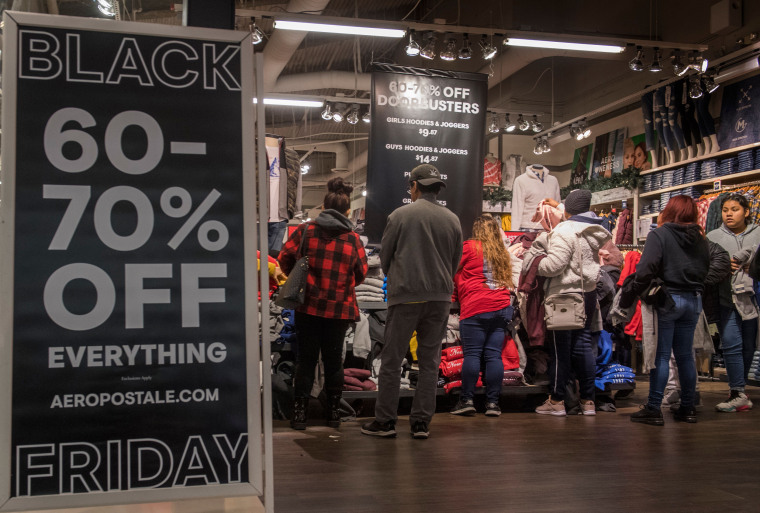The newest reading on consumer sentiment from the University of Michigan’s Surveys of Consumers shows that Americans are feeling pretty upbeat these days.
Two new metrics on consumer holiday-season spending published this week found that consumer spending held up through the all-important holiday season: The National Retail Federation said that retail sales in November and December — excluding restaurants, gasoline and cars — totaled just over $730 billion, a year-over-year increase of 4.1 percent. The Commerce Department said retail sales rose by 0.3 percent in December. When cars and gasoline — two volatile components — were excluded, retail sales grew by 0.5 percent for the month.
These figures were buoyed by steady consumer sentiment, which remained roughly flat in December. The baseline sentiment index ticked down a tiny bit from 99.3 to 99.1, and the outlook of current conditions rose by 0.3 points. Although the Index of Consumer Expectations slipped by 0.7 points, this still represents a year-over-year increase of 10.5. All three metrics — Consumer Sentiment, Current Economic Conditions and Consumer Expectations — have risen year-over-year, reflecting a recovery from worries about the Federal Reserve and the government shutdown that started 2019.
“Consumers will continue to sustain the expansion due to their favorable judgements about their current and prospective financial situation,” Surveys of Consumers chief economist Richard Curtin wrote in the accompanying analysis.
“Consumer spending is the pillar on which the economic expansion rests,” said Greg McBride, chief financial analyst at Bankrate.com.
There are a few good reasons for this optimism, he added. “We’ve got unemployment at a 50-year low, growth in household income and growth in real spending power for most households.”
“The sharp downturn in growth apparently promised by the weakening of business surveys from the spring through the early fall has not materialized,” Ian Shepherdson, chief economist at Pantheon Macroeconomics, wrote in a client note. Pantheon revised its 2020 GDP average quarterly growth forecasts upward from 1.5 percent to 2 percent as a result, Shepherdson added.
Mark Zandi, chief economist at Moody’s Analytics, said the meteoric rise in the stock market also contributes a potent wealth effect that can stimulate spending. “The wealth effect, the rising stock market should be adding about half a point of GDP growth in 2019 and are on track to do about the same in 2020,” he said.
“That supports consumer confidence. That helps in terms of cash — stockholders can realize those gains, it makes it easier for them to borrow,” Zandi said.
The increase in borrowing rates also is helped along by a combination of low interest rates and economic optimism. A forecast from credit bureau TransUnion predicted that Americans will take on more debt this year, including mortgages, credit cars, car and personal loans. “Some households are in fact relying on debt to meet necessities, but that’s not the base case. The majority of it is optimism with regard to employability, income and the ability to repay that debt,” McBride said.
According to a new Bankrate survey, 84 percent of people expect their finances to either improve or stay the same in 2020. “Only 1 in 6 Americans expect their financial situation to get worse this year. That ties back to that willingness to spend and comfort with taking on debt in moderation,” McBride said. “68 percent of economic output comes from consumer spending. As long as that virtuous cycle retains intact, we can keep recession at bay.”
Some market observers, though, argued that comparative sales should have been even higher, given the economic fundamentals at play. “It’s really an easier year-over-year comparison,” said Camilla Yanushevsky, equity analyst at CFRA Research.
The partial government shutdown that stretched on for weeks, worry about rising interest rate and waning tax cut stimulus all combined to put a damper on consumer activity towards the end of 2018, Yanushevsky said. NRF data found that holiday spending in 2018 grew at a rate of just over 2 percent.
“I’m surprised sales weren’t stronger,” Zandi said. “Last December was a disaster. I expected Christmas sales, because of the easy comparison, to be closer to 5 percent.”
Many suspect trade could be putting a drag on recent results. Shepherdson flagged tariffs as a risk factor to continued economic growth. “Both the direct effects of the tariffs — a tax on consumers and businesses — and the accompanying uncertainty will continue to constrain economic growth indefinitely,” he said.
Yanushevsky pointed out that in spite of this week’s China trade deal, the majority of tariffs remain in place, which constrains the rate of expansion. “We think that’s going to stifle economic growth,” she said, predicting that the impact to consumers will be magnified as more companies pass along their higher costs. “It’s still chipping into people’s wallets,” she said.
“The trade war hurt manufacturing, really hurt business investment” in 2019, Yanushevsky said, predicting retail sales growth of 3 percent for this year. “We think there’s going to be a more material spillover in 2020.”
